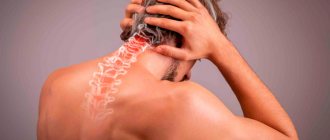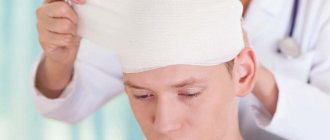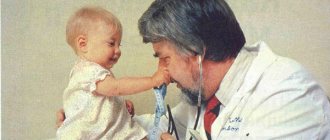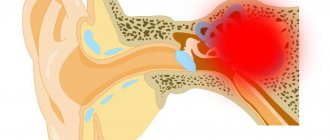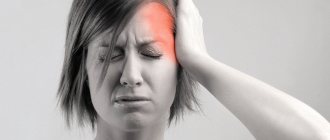Ear pain is a fairly common symptom. Painful sensations in this case give the patient a lot of unpleasant moments, and it is very difficult to simply “endure” such pain. It is noteworthy that pain in the ear is not always associated with diseases of the hearing organ. Such painful sensations can also be caused by other organs that radiate, that is, “giving off,” to the ear. A condition in which the ear hurts, but there is no inflammation in it, is called otalgia.
Otalgia can be caused by many reasons:
Temporal arteritis
The disease is an inflammation of the vessels of the temporal artery.
If the inflammatory process spreads to the ear artery, the patient will also experience pain in the ears. This disease is typical for older women. It causes blurred vision, headaches, pain in the temples, and increased fatigue. Make an appointment right now! Call us by phone or use the feedback form
Sign up
Along the branches of the vagus nerve, pain can radiate to the ear from the esophagus, thyroid gland, and organs of the cardiovascular system.
If you have ear pain, you should definitely consult with an otolaryngologist, since this condition may signal the presence of serious diseases in the body. If the ear is healthy, no abnormalities have been identified, and the pain does not go away, it is necessary to diagnose the nose, larynx, pharynx and, if necessary, other organs to identify the cause of otalgia. Further treatment will depend on the diagnosis.
Signs that pain in the cervical region is radiating to the head
This symptom is usually characterized by initial pain in the neck, after which it “shifts” to the head. Neck pain is most often caused by various pathological processes occurring in this area:
- inflammatory;
- degenerative-dystrophic;
- traumatic origin.
Headaches that occur due to problems in the cervical spine are called cervical. It is different from “classic” migraine. Cervical pain is usually defined as dull pain, often localized in the back of the head, but sometimes spreading to the temples and eyes. Even less commonly, it appears in the upper part of the head (forehead and crown), as well as in the ear area. This pain is often accompanied by:
- stiffness and pain in the neck (when trying to turn the head);
- tingling or numbness in the shoulder girdle and arms;
- dizziness (with nausea);
- ringing in the ear;
- inability to concentrate;
- muscle weakness;
- depression.
According to the nature of its manifestation and connection with the provoking pathological mechanism, cervical pain can be:
- arteriospastic (aching pain is observed in all parts of the head);
- arteriodilatatory (pain of a pulsating nature is localized in the temples and back of the head);
- venous (pressing pain in the morning);
- muscular-tonic (aching in nature, encircling the parietal region with a “hoop”);
- liquor-hypertensive (bursting in nature with pressure on the eyes);
- neuralgic (with attacks of “shooting” pain).
Symptoms
The main symptom that unites all these conditions is pain in the ear and neck . Depending on the diagnosis, other symptoms appear, which, however, often overlap in different pathological processes. This is due to the fact that many of them affect the nerve endings of the spine, disrupting blood circulation and supply to the brain. Therefore, they are often accompanied by dizziness, unsteadiness, loss of coordination, nausea and vomiting. Inflammatory processes are characterized by increased temperature and impaired mucus outflow.
Mumps, which is popularly called mumps, is manifested by swelling , maybe on one side or both. The pain intensifies when pressing on the neck area under the ear, as well as when chewing and swallowing.
Neuralgia of the facial nerve, accompanied by impaired facial expressions , shooting pain.
Inflammation of the maxillary sinuses is usually characterized by increased pain when bending over and nasal congestion on one side.
With arterial hypertension, there is a persistent increase in blood pressure .
Who more often experiences pain in the cervical spine radiating to the head?
This symptom does not depend on race, gender, or age. Moreover, it is usually more often observed in people aged 20 to 60 years and older (since it is directly related to the development of cervical osteochondrosis, which affects almost 90% of people after 65 years). According to statistics, cervical pain is most often recorded in those who:
- has a sedentary job in an office at a computer;
- works professionally as a driver;
- associated with regular strength loads (professionally or in sports);
- has chronic problems with normal cerebral circulation;
- suffered injuries to the cervical spine;
- has a genetic predisposition.
Homeopathic treatment
Treatment with alternative medicine methods gives a longer lasting effect , unlike painkillers. As a rule, homeopathy is resorted to when all medical methods have already proven powerless.
Symptomatic homeopathic treatment is used to relieve symptoms and is then continued with constitutional remedies that are suitable for the individual patient. Drugs are selected individually, taking into account external data, symptoms and the patient’s reactions to stimuli, both psychological and physiological.
Symptomatic drugs have a more general effect , they are suitable for different patients with similar symptoms.
Photo 2. A homeopathic doctor will help you understand the choice of medicine. Source: Flickr (BOIRON RUSSIA).
To eliminate pain in the ear and neck, the following emergency homeopathic therapy is used:
- Aconite is indicated for ear pain caused by infection. The patient feels a throbbing pain, which manifests itself more clearly when entering a warm room from the cold; the patient is thirsty and has a fever.
- Agaricus is prescribed for neuralgic pain, when it feels like ice needles are digging into the neck and ear.
- Verbascuv - pain radiating to the ear, paroxysmal, which most often manifests itself in the morning or afternoon.
- Hina (China) - throbbing pain in the neck, feeling like the head is exploding.
- Pulsatilla - is prescribed to treat ear infections, pain accompanied by irritability and tearfulness.
- Silicea is used for neck muscle weakness and stiffness.
- Aurum helps with muscle pain in the head and neck area.
Prevention
Preventive measures are associated with available physical activity and strengthening the muscle corset.
In order to protect yourself from infection, it is important to increase the body's immune defense , not only using hardening methods, but also using homeopathic remedies that perfectly stimulate the immune system, restoring the balance of all systems in the body.
An active lifestyle and proper nutrition also help strengthen bone tissue; reasonable training makes muscles strong.
Inflammation of the inner ear (labyrinthitis)
The labyrinth is an organ of hearing and balance, is richly innervated and includes auditory and kinetic receptors, so its inflammation causes:
- severe ear pain and headaches;
- a sharp decrease in hearing, the appearance of noise, crackling, squeaking in the ear;
- dizziness, nausea, loss of orientation in space, horizontal nystagmus.
Labyrinthitis occurs as a result of the penetration of infection in various ways from different parts and cavities of the body:
- from the middle ear with untreated or advanced otitis media;
- with infected meninges during meningitis;
- with blood for diseases such as syphilis, tuberculosis, herpes;
- damage to the temporal region, the organ of hearing with disruption of the integrity of cells and blood vessels.
The disease requires immediate medical attention.
Neuralgia ear and head
pain appears , it is associated with various diseases, and the discomfort that a person experiences can radically affect the quality of his life.
The quality of sleep noticeably deteriorates, appetite sharply decreases, a person gets tired very quickly, irritability and lethargy appear. In this case, a person may constantly experience severe headaches, nausea and dizziness.
In order for a doctor to accurately diagnose a patient who has pain behind the ear, examinations and tests must be performed.
Doctors consider the main symptoms to be:
- a sharp increase in body temperature;
- malaise;
- unpleasant sensations even with slight pressure;
- edema;
- hearing loss;
- there are cases of pus discharge (if the disease is associated with the hearing aid).
To prevent negative consequences, doctors most often use strong antibiotics and anti-inflammatory drugs. They can be in the form of ointments or drops.
Diagnostic methods
It is often difficult to determine the disease only by external signs, so a more detailed examination is required. The condition requires an integrated approach in diagnostic methods, which includes taking an anamnesis and examination by a doctor , as well as both laboratory tests and x-rays to clarify the diagnosis, as well as special studies , including electromyography, MRI and CT.
What diseases cause pain in the cervical region to radiate to the head?
The most common causes of this symptom are the following diseases or pathological conditions:
- cervical osteochondrosis – observed in almost 90% of elderly people, which is associated with age-related deformation of the bones and cartilage that make up the cervical spine, with severe pain localized at the base of the skull, in the temples, often accompanied by decreased vision (against the background of eye “fatigue”), can also develop due to a passive lifestyle, excess weight or genetic predisposition;
- spinal injuries – including microtraumas received from impacts, falls during sudden braking or acceleration while the vehicle is moving;
- circulatory disorders - due to hypertension, or insufficient blood flow to the brain due to atherosclerosis of the vertebral artery;
- cervico-occipital neuralgia - pain spreads along the head, covering the temples, eyes and forehead (in the direction of the affected nerve);
- stress and physical or mental exhaustion - neck pain radiating to the head, in this case, serves as a prerequisite for the development of osteochondrosis.
Treatment methods
The treatment regimen for headaches is selected individually. It depends on the type of pain, the frequency and nature of its manifestation, as well as the age of the patient and the presence of concomitant diseases. Treatment may include the following steps:
- antibiotic therapy - administration of antibacterial drugs orally or in the form of injections, if the bacterial cause of inflammation is confirmed;
- drug treatment - an individual regimen that includes painkillers, anti-inflammatory drugs, muscle relaxants and other drugs;
- methods of recovery from injuries, including physiotherapy, therapeutic exercises and massage - they are also effective in the initial stages of osteochondrosis;
- specific drugs to increase or decrease blood pressure;
- Surgical treatment is prescribed only when conservative methods are insufficiently effective, including abscesses, hernias, and purulent diseases of the hearing organ.
The Clinical Brain Institute specializes in the treatment of headaches. General and individual diagnostic and therapy programs have been developed here, which are adapted separately for each patient. Modern equipment, competent specialists, the possibility of round-the-clock observation in a hospital setting - these advantages make it possible to timely identify pathology and carry out its comprehensive treatment.
Clinical Brain Institute Rating: 5/5 — 4 votes
Share article on social networks
Treatment
Treatment of inflammatory ear diseases includes:
- antibacterial, antiviral agents of local and general action;
- antipyretics, analgesics;
- physiotherapy;
- in some cases - surgical intervention.
Treatment must be based on accurate diagnosis, which is impossible outside a specialized clinic. The high professionalism of CELT specialists allows us to identify various diseases of the hearing organ and choose the most effective means of solving the problem.
Make an appointment through the application or by calling +7 +7 We work every day:
- Monday—Friday: 8.00—20.00
- Saturday: 8.00–18.00
- Sunday is a day off
The nearest metro and MCC stations to the clinic:
- Highway of Enthusiasts or Perovo
- Partisan
- Enthusiast Highway
Driving directions

